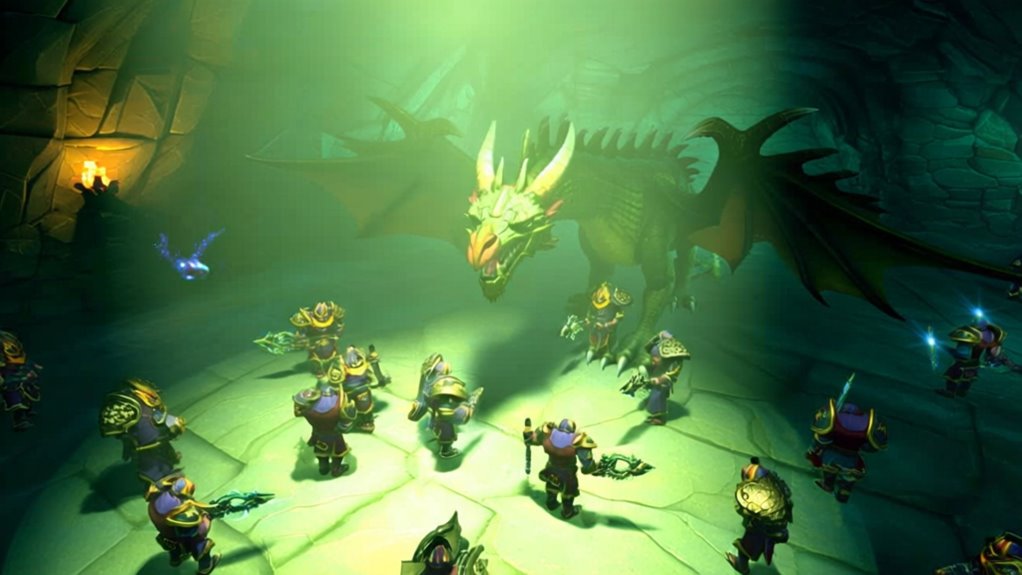A Deep Dive Into Raiding in WoW Classic
The Origins of Raiding in Azeroth in WoW
When delving into the origins of raiding in Azeroth, it's crucial to understand that this cornerstone of World of Warcraft (WoW) wasn't just about battling formidable foes for loot; it was about fostering a sense of community and teamwork.
 The raiding history in WoW traces back to the game's inception, where early guilds formed the backbone of these epic adventures. In those days, players weren't just individuals seeking treasure but part of something larger—a collective striving towards a common goal.
The raiding history in WoW traces back to the game's inception, where early guilds formed the backbone of these epic adventures. In those days, players weren't just individuals seeking treasure but part of something larger—a collective striving towards a common goal.
Raiding in Azeroth required coordination and strategy, and early guilds became hubs of collaboration. You'd spend countless hours strategizing and perfecting techniques with your guildmates. Each victory wasn't just a personal achievement; it was a shared triumph that reinforced bonds. The challenges of early raids, like Molten Core, tested not only your skill but the strength of your guild's unity, shaping the social fabric of the WoW community.
The Role of Guilds in Raiding
Central to the raiding experience in WoW Classic is the pivotal role played by guilds, acting as the glue that holds the raiding community together. Joining a guild is more than just finding a group; it's about embracing a guild culture that values progression mindset and team cohesion. Effective raid leadership relies on communication strategies and organized raid organization to ensure everyone understands their role specialization. Guild recruitment focuses on finding players who fit well with the team's dynamics and share the guild's goals.
Conflict resolution and member accountability are critical for maintaining harmony and focus. Here's a look at how these elements interact:
Aspect Importance Outcome
| Guild Recruitment | Ensures right fit | Stronger team cohesion |
| Raid Leadership | Guides the team | Smooth raid organization |
| Communication Strategies | Enhances clarity | Effective conflict resolution |
| Role Specialization | Optimizes performance | Facilitates progression mindset |
Together, these elements craft a well-oiled raiding machine.
Pre-Raid Preparation and Strategy
Before you even step into a raid in WoW Classic, thorough pre-raid preparation and strategy are imperative for success. Start by focusing on gear acquisition to ensure that you and your team have the optimal equipment for your roles. Understanding raid composition is crucial; a well-balanced team with strong class synergy can make or break your raid. Consumable preparation is another essential step; stock up on potions, food, and flasks to boost your performance.
Engage in strategy meetings to discuss tactics and assign roles. Utilize raid addons for better coordination and communication. Adhering to pre-raid etiquette, such as being punctual and prepared, shows respect for your team. Dive into encounter research to understand boss mechanics and plan accordingly. Conduct practice runs to refine your approach and enhance team coordination. By methodically addressing these elements, you'll be well-equipped to conquer the challenges that await in WoW Classic raids.
Iconic Raid Instances and Bosses
In WoW Classic, legendary raid challenges await you, each featuring bosses that have become iconic in the gaming world. You'll encounter memorable foes like Ragnaros in the molten depths of the Molten Core or Onyxia in her lair, each requiring unique strategies and teamwork to conquer. Analyzing these encounters reveals why they've captivated players for years, blending intricate mechanics with epic storytelling.
Legendary Raid Challenges
Awe and challenge intertwine in the legendary raid instances of WoW Classic, offering a thrilling test of skill and strategy. As you step into these iconic dungeons, you're not just battling formidable foes; you're vying for legendary loot that can define your character's legacy. Each epic encounter demands coordination, precise execution, and a deep understanding of your class. It’s not just about raw power but using your abilities strategically to overcome seemingly insurmountable odds.
Navigating these raids requires patience and perseverance. You’ll need to adapt to dynamic combat scenarios, where each decision could mean the difference between victory and defeat. The camaraderie and teamwork forged in these trials create unforgettable memories, as you conquer challenges that echo through the halls of Azeroth's history.
Memorable Boss Encounters
When you delve into the heart of WoW Classic's raid instances, the memorable boss encounters stand out as epic tests of both individual skill and group synergy. Legendary battles like Ragnaros in Molten Core, with its iconic mechanics and epic loot, are etched in raid nostalgia. These challenging fights demand precise player strategies and adaptive boss tactics, fostering unforgettable moments. Community highlights often center around these encounters, where defeating a boss solidifies your guild's reputation. Iconic fights like Nefarian’s class calls in Blackwing Lair or C'Thun's eye beam in Ahn'Qiraj require seamless coordination. These encounters are not just tests of gear but also of communication and teamwork, transforming raids into legendary experiences that resonate deeply with players.
Class Roles and Responsibilities
Understanding the intricacies of class roles and responsibilities in WoW Classic can significantly enhance your raiding experience. As a tank, your primary responsibility is threat management and positioning strategies to keep enemies focused on you while minimizing damage taken. Healers, on the other hand, are tasked with keeping everyone alive through meticulous cooldown usage and prioritizing healer duties when the raid’s health dips dangerously low. If you're playing a damage role, maximizing your output and assisting with debuff monitoring is crucial to ensure bosses fall swiftly.
Crowd control is another vital element, allowing you to manage additional enemies and reduce chaos during encounters. Buff management and ensuring all raid members have the necessary enhancements can turn the tide of battle. Effective raid coordination involves communication and understanding each role’s contributions, ensuring everyone knows their positioning and responsibilities. When executed flawlessly, these elements create a harmonious and successful raiding environment.
Loot Distribution and Its Impact
When you’re part of a raiding guild in WoW Classic, understanding how loot distribution works can significantly impact your experience. Loot Council dynamics often lead to debates about fairness, as the decision-making process can sometimes seem subjective. On the other hand, the DKP system introduces its own set of challenges, such as inflation and hoarding, which you’ll need to navigate to maximize your rewards.
Loot Council Dynamics
Navigating the intricacies of loot council dynamics in WoW Classic requires a keen understanding of both human behavior and game mechanics. Loot council strategies hinge on balancing gearing priorities with fairness perceptions. The council’s composition is crucial—diverse voices can help mitigate player trust issues and guild politics. However, communication barriers may arise, complicating council decision making. Implementing transparency initiatives ensures everyone understands the decision process, fostering trust. Still, conflicts can occur, so effective conflict resolution is vital. A successful loot council needs clear communication channels to address concerns and maintain fairness. As you engage with these dynamics, remember that the goal is a harmonious environment where players feel valued and rewarded, enhancing the overall raiding experience.
DKP System Challenges
Though the DKP (Dragon Kill Points) system offers a structured approach to loot distribution in WoW Classic, it brings its own set of challenges that can impact guild dynamics. You might find that while the system promotes fairness and transparency, it can also fuel unhealthy competition among players. The emphasis on earning points can overshadow the camaraderie of raiding, leading to potential friction. Moreover, the system's flexibility varies from guild to guild, with some adopting strict rules and others allowing for more leniency. This can create inconsistencies in perceived fairness. Accountability is another concern, as maintaining accurate records requires diligence. Finally, variations in the DKP system can lead to confusion, with members unsure of how points will affect their loot opportunities.
The Social Dynamics of Raiding
In any WoW Classic raid, the intricate web of social dynamics plays a pivotal role in shaping the group's success and cohesion. You'll find that effective raid communication strategies are the backbone of this complex environment. Clear and precise communication ensures that everyone knows their roles and responsibilities, which is crucial given the need for synchronized actions. But it's not just about giving orders; it's about fostering a collaborative atmosphere where every player feels valued.
Conflict is inevitable in such a high-stakes setting, but how you handle it can make or break your raid. Player conflict resolution requires empathy and diplomacy. It's essential to address disagreements promptly and fairly, ensuring that personal disputes don't undermine group objectives. By promoting an inclusive and respectful environment, you can maintain morale and focus, driving your raid team toward success. Remember, a raid is as much about people as it is about strategy.
Challenges and Triumphs in 40-Man Raids
While tackling 40-man raids in WoW Classic, you encounter both formidable challenges and exhilarating triumphs. Managing raid mechanics and crafting boss strategies are crucial. It’s imperative to foster group synergy and ensure encounter coordination. With 40 players, communication challenges abound, demanding clear guidance and role expectations.
Adaptability in fights is non-negotiable; unexpected changes require quick timing execution. Debuff management becomes vital, as failing to cleanse or avoid them can lead to disaster. Healers must perfect heal distribution, ensuring everyone stays alive amid chaos. Meanwhile, damage output needs to hit benchmark levels to avoid enrage timers and secure victory.
The triumphs in these raids arise when all elements align, and the raid seamlessly executes its plan. Overcoming these trials not only brings epic loot but also a sense of accomplishment that few other gaming experiences can replicate. Your team’s perseverance and skill lead to legendary victories.
The Evolution of Raiding Over Time
As you delve into the evolution of raiding over time, you’ll notice how World of Warcraft has transformed the landscape of these epic encounters. From WoW Classic to the latest expansions, raid mechanics evolution has been significant, with developers continuously refining the complexity and interactivity of boss fights. Early raids demanded coordination across massive 40-man groups, focusing on endurance and basic mechanics. However, modern raids now feature intricate phases and mechanics that require precise execution and communication.
Difficulty scaling changes have also played a pivotal role in this evolution. Originally, raids had fixed difficulty levels, but recent expansions introduced flexible scaling. This allows players to choose from Normal, Heroic, and Mythic difficulties, tailoring encounters to their group's skill level. These changes have made raiding more accessible while still offering hardcore players challenging content. Ultimately, these evolutions reflect Blizzard's commitment to keeping raiding engaging and inclusive for all players.
Frequently Asked Questions
What Are the Most Common Mistakes New Raiders Make?
You're likely to overlook gear management and lack encounter awareness. Not checking your equipment or understanding boss mechanics can lead to mistakes. Always optimize your gear and study fight strategies to avoid these common pitfalls.
How Does Raid Composition Affect Success Rates?
Raid composition's impact on success rates is profound; a balanced mix of raid roles ensures harmony. You need damage dealers for power, healing classes for survival, and tank synergy. Class diversity enhances adaptability, making triumph more attainable.
What Tools Can Assist With Raid Communication and Coordination?
You’ll find voice chat essential for real-time discussions. Raid addons like Deadly Boss Mods enhance coordination, while tools like Discord streamline team communication. Effective communication strategies ensure everyone’s synchronized, boosting your raid’s success and efficiency.
How Do Players Resolve Conflicts Within a Raid Group?
You resolve conflicts in a raid group by using effective conflict resolution strategies, like open communication and mediation. Leadership roles play a critical part by facilitating discussions, ensuring everyone's heard, and guiding the team towards compromise and unity.
What Are the Best Practices for Managing Raid Fatigue?
To manage raid fatigue, you should balance raid schedules and offer player incentives. Ensure breaks are included, set realistic goals, and reward progress. Engaging leadership keeps morale high, making the raiding experience enjoyable and sustainable.



